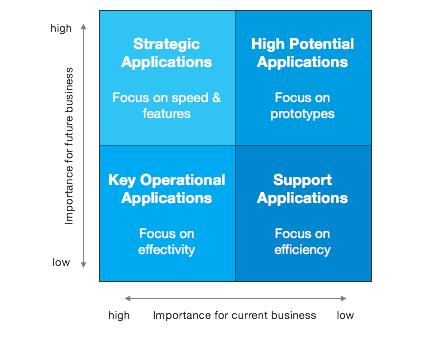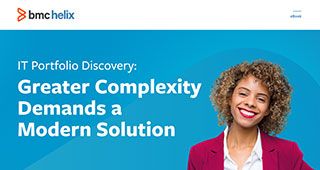Business organizations experience an increasing application portfolio complexity as they invest in long-term technology solutions.
Applications designed to solve a particular set of problems in the present technology landscape may no longer be relevant or feasible in the near future. Yet, these organizations are locked into using legacy applications that incur high maintenance costs, bottleneck performance, and are all too often a nightmare to replace with the latest and greatest technologies available in the market today.
This challenge can be attributed to inadequate application portfolio management.
What is application portfolio management?
Application portfolio management (APM) refers to the process of planning and evaluating applications and creating the framework for measuring and optimizing the use of applications over the entire course of their lifecycle.
APM is a closed-loop planning process that incorporates metrics for application retirement into the acquisition process.
A simple APM maturity model
Organizations accumulate IT assets as they grow or merge with other companies. This growth is good, but it often leaves out the important work of integrating operations, apps, and infrastructure.
The growing asset portfolio therefore doesn’t always align with organizational goals and strategies over the long term, yet organizations are forced to retain legacy technologies at the expense of operational efficiencies. The inevitable retirement of legacy apps is ultimately met with cost overruns and project delays as organizations move to new cloud-based alternatives.
(Explore enterprise asset management & best practices.)
So, a systematic framework is required to assess the future derived value contributions of applications to the success of the business over the course of the application lifecycle. To this end, several models and frameworks evaluate a variety of metrics and key performance indicators (KPIs).
One popular APM framework, the Strategic Grid Application Portfolio Matrix, provided by Ward et. al. (2002), offers a simple approach to analyze application value across four key value segments:

(Source)
Let’s look at each of the categories, starting with the top right.
High Potential Applications
- Why: Unclear
- What: Uncertain
- How: Unknown
With high potential applications, the technology on its own, off the shelf, does not guarantee business value. In order to maximize the value potential of this technology, organizations must:
- Adapt existing operations
- Integrate the technology into the complex systems
- Provide appropriate and useful workflows
Of course, integrating new technology requires carefully vetting and planning against potential new risk vectors. For instance, IT workloads migrated to the cloud face different cybersecurity risks compared to assets stored in on-premises data center deployments.
Finally, it’s important to control costs: while many cloud solutions are easy to get into, switching between vendors is often expensive and cumbersome.
Strategic Applications
- Why: Finding the strategic importance
- What: The systems and framework required to realize strategic advantages
- How: The planning process leading to the required system capabilities
The business landscape is inherently dynamic and often unpredictable. Which is why it’s so challenging to associate the right strategic importance to a potential application for business value improvement. Instead, improvements in application portfolio should be driven by:
- Ongoing improvements in the business process
- Competitive strength
- Returns on IT investments
At the same time, you’ll need to anticipate the risks, particularly the requirements associated with cybersecurity and user privacy regulations.
In recent years, many government institutions around the world have forced enterprises to reshape their IT strategy and transform how applications interact with users and user data. Failing to account for such risks and incorporate stringent regulatory compliance into technology-driven operations can directly affect the future value of new applications added to the portfolio.
Key Operational Applications
- Why: To achieve operational excellence
- What: Identify operational activities and workflows impacting business value
- How: The planning process leading to the required operational workflows
Change is difficult, especially when it comes to your ways of doing business. Changes in operational workflows are resource intensive and fail often. Therefore, change purely to introduce a new technology capability should be analyzed for risks and rewards carefully before investing in a change program.
In this quadrant, the applications tend to incur high maintenance cost. These metrics should be thoroughly analyzed and evaluated before procuring new products.
(Learn about organizational change best practices.)
Support Applications
- Why: To improve cost and performance efficiency of the apps
- What: Consider existing applications only
- How: The planning process leading to improvements in existing application portfolio
Any improvements in the app may require custom features and changes to integrate with the existing set of technologies. In-house technologies are designed specifically for the organization’s internal operations and business process.
On the other hand, off-the-shelf technology solutions are developed for the broad market, satisfying a wide set of requirements but lacking organization-specific capabilities. These capabilities can be introduced through customizations but expose customers to risks such as:
- Dependability issues
- High cost for application changes, support, and troubleshooting
That’s why it might be advantageous to adjust business activities to suit the off-the-shelf technology capabilities that are designed to work over the long term, maintaining high returns on investments over the course of its lifecycle. Any changes to the apps should be justified by the resulting competitive advantages and business value.
Application portfolio management
As organizations supply employees with more apps for working efficiently, the number of applications and services might grow. Performing your due diligence in the form of application portfolio management will help you streamline the sprawl.







